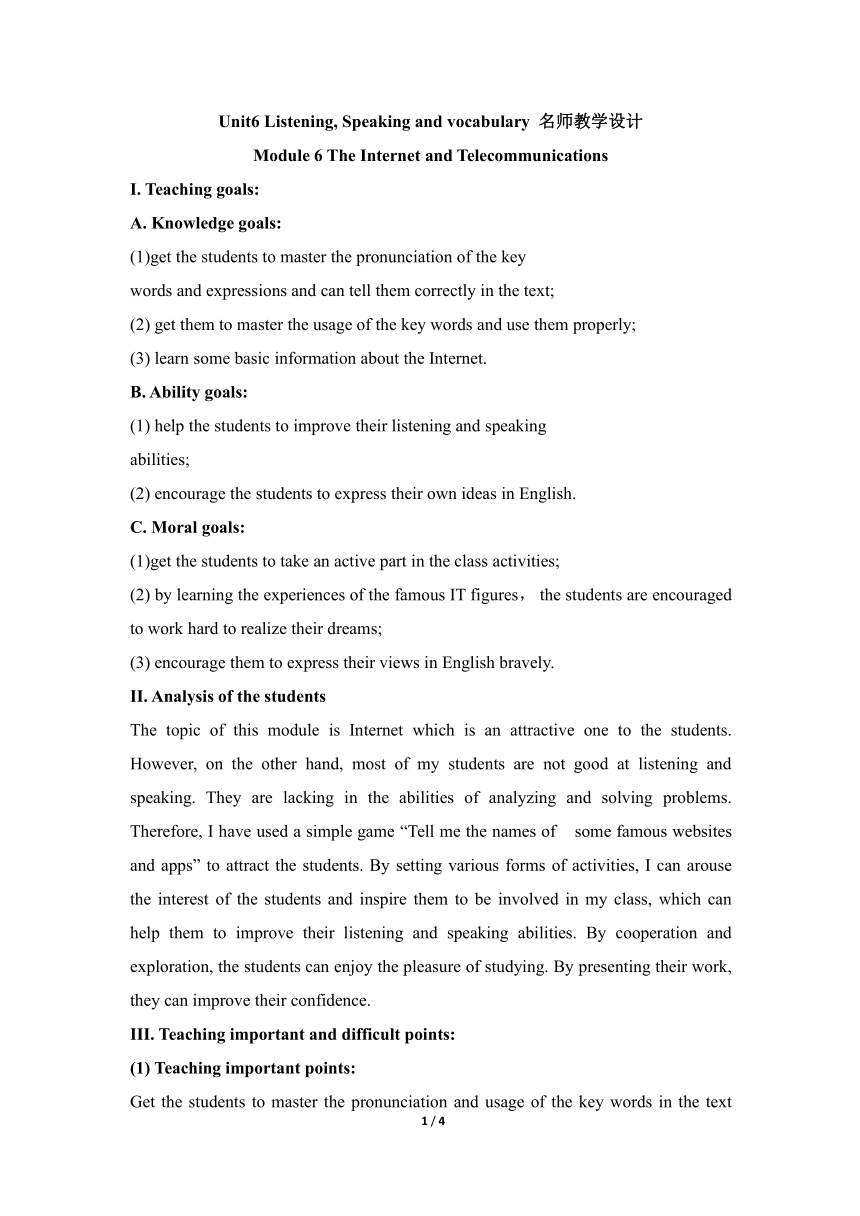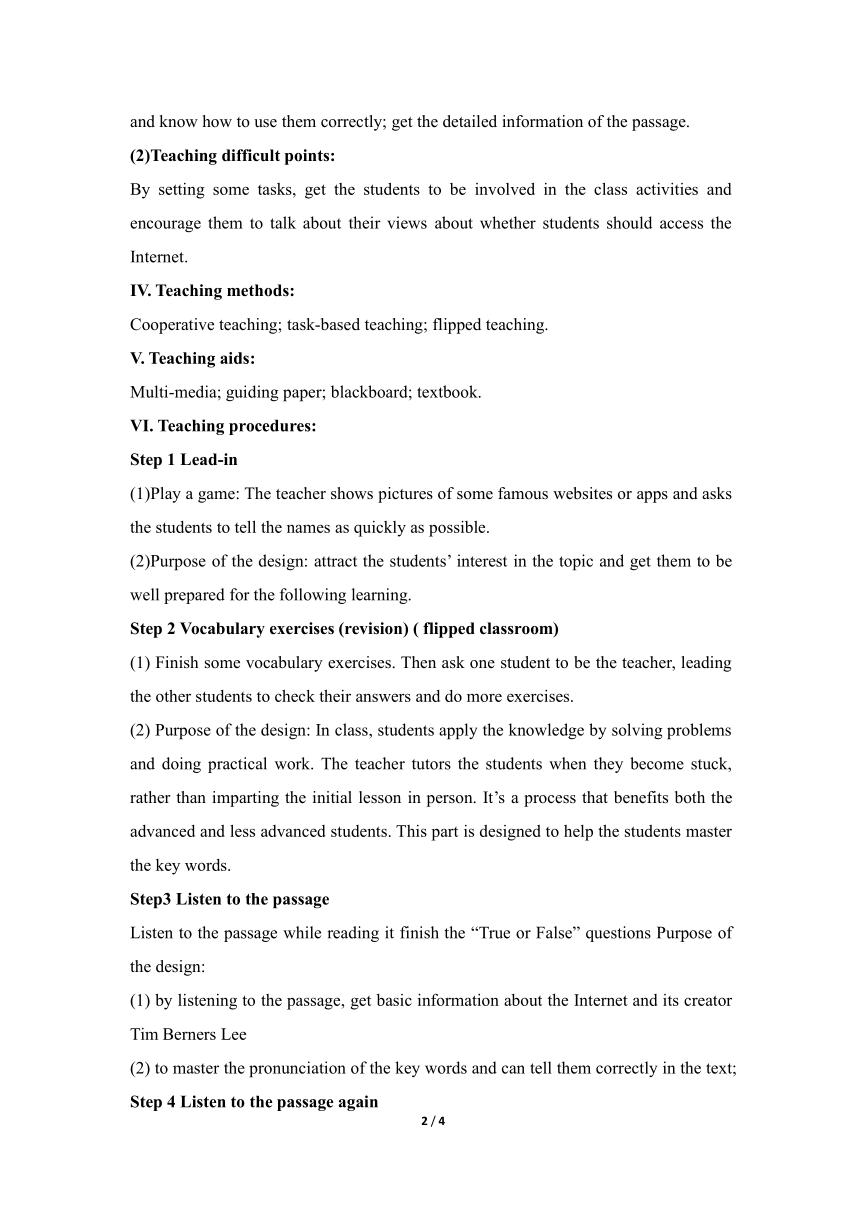外研版必修1 Module6The Internet and Telecommunications Listening and Vocabulary_名师教学设计
文档属性
| 名称 | 外研版必修1 Module6The Internet and Telecommunications Listening and Vocabulary_名师教学设计 |

|
|
| 格式 | doc | ||
| 文件大小 | 43.5KB | ||
| 资源类型 | 教案 | ||
| 版本资源 | 外研版 | ||
| 科目 | 英语 | ||
| 更新时间 | 2023-02-13 13:08:39 | ||
图片预览


文档简介
Unit6 Listening, Speaking and vocabulary 名师教学设计
Module 6 The Internet and Telecommunications
I. Teaching goals:
A. Knowledge goals:
(1)get the students to master the pronunciation of the key
words and expressions and can tell them correctly in the text;
(2) get them to master the usage of the key words and use them properly;
(3) learn some basic information about the Internet.
B. Ability goals:
(1) help the students to improve their listening and speaking
abilities;
(2) encourage the students to express their own ideas in English.
C. Moral goals:
(1)get the students to take an active part in the class activities;
(2) by learning the experiences of the famous IT figures, the students are encouraged to work hard to realize their dreams;
(3) encourage them to express their views in English bravely.
II. Analysis of the students
The topic of this module is Internet which is an attractive one to the students. However, on the other hand, most of my students are not good at listening and speaking. They are lacking in the abilities of analyzing and solving problems. Therefore, I have used a simple game “Tell me the names of some famous websites and apps” to attract the students. By setting various forms of activities, I can arouse the interest of the students and inspire them to be involved in my class, which can help them to improve their listening and speaking abilities. By cooperation and exploration, the students can enjoy the pleasure of studying. By presenting their work, they can improve their confidence.
III. Teaching important and difficult points:
(1) Teaching important points:
Get the students to master the pronunciation and usage of the key words in the text and know how to use them correctly; get the detailed information of the passage.
(2)Teaching difficult points:
By setting some tasks, get the students to be involved in the class activities and encourage them to talk about their views about whether students should access the Internet.
IV. Teaching methods:
Cooperative teaching; task-based teaching; flipped teaching.
V. Teaching aids:
Multi-media; guiding paper; blackboard; textbook.
VI. Teaching procedures:
Step 1 Lead-in
(1)Play a game: The teacher shows pictures of some famous websites or apps and asks the students to tell the names as quickly as possible.
(2)Purpose of the design: attract the students’ interest in the topic and get them to be well prepared for the following learning.
Step 2 Vocabulary exercises (revision) ( flipped classroom)
(1) Finish some vocabulary exercises. Then ask one student to be the teacher, leading the other students to check their answers and do more exercises.
(2) Purpose of the design: In class, students apply the knowledge by solving problems and doing practical work. The teacher tutors the students when they become stuck, rather than imparting the initial lesson in person. It’s a process that benefits both the advanced and less advanced students. This part is designed to help the students master the key words.
Step3 Listen to the passage
Listen to the passage while reading it finish the “True or False” questions Purpose of the design:
(1) by listening to the passage, get basic information about the Internet and its creator Tim Berners Lee
(2) to master the pronunciation of the key words and can tell them correctly in the text; Step 4 Listen to the passage again
(1)While listening, finish the ask and answer question and make them dialogue
(2)Purpose of the design:
(1) have a better understanding of it;
(2) practice students’ spoken English
Step 5 Listen and cooperation
(1)listen to the passage again; after the listening ,give each group an envelope with answer sheet in it; finish the attachment in teamwork
(2)Purpose of the design: by discussing and cooperation in groups, the students learn how to work as a team and improve their hands-on ability
Step 6 Fill in the blanks
(1)Ask students to finish their by themselves and then read the answer together aloud
(2)Purpose of the design: let students have better grasp of the whole passage and practice their spoken English
Step 7 Debate and Consolidation (flipped classroom)
(1)The teacher will put forward the topic “Is it good or bad for the Ss to access the Internet ” ;give the useful words and phrases leant today as a help; ask a student to be the judge and host the debate
(2)Purpose of the design: to deepen the students’ understanding of the passage; practice students’ thinking ability; give students chance and courage to show their charm
Step8 Sublimation
(1) The teacher tell the story about Mayun’s great difficulty he’d been through before his success; encourage student to dream big, believe in themselves ,work hard and never give up
(2) Purpose of the design: through Myun’s story, lead students to build a strong spirit
Step 9 Homework
(1)Read the passage again and review the new words and expressions; Write a composition(about 100words):Is it good or bad for us students to access the Internet; Read a passage about the Internet
(2)Purpose of the design: to consolidate and expand what the students have learnt in the lesson and make full use of the key words and expressions in the passage
3 / 4
Module 6 The Internet and Telecommunications
I. Teaching goals:
A. Knowledge goals:
(1)get the students to master the pronunciation of the key
words and expressions and can tell them correctly in the text;
(2) get them to master the usage of the key words and use them properly;
(3) learn some basic information about the Internet.
B. Ability goals:
(1) help the students to improve their listening and speaking
abilities;
(2) encourage the students to express their own ideas in English.
C. Moral goals:
(1)get the students to take an active part in the class activities;
(2) by learning the experiences of the famous IT figures, the students are encouraged to work hard to realize their dreams;
(3) encourage them to express their views in English bravely.
II. Analysis of the students
The topic of this module is Internet which is an attractive one to the students. However, on the other hand, most of my students are not good at listening and speaking. They are lacking in the abilities of analyzing and solving problems. Therefore, I have used a simple game “Tell me the names of some famous websites and apps” to attract the students. By setting various forms of activities, I can arouse the interest of the students and inspire them to be involved in my class, which can help them to improve their listening and speaking abilities. By cooperation and exploration, the students can enjoy the pleasure of studying. By presenting their work, they can improve their confidence.
III. Teaching important and difficult points:
(1) Teaching important points:
Get the students to master the pronunciation and usage of the key words in the text and know how to use them correctly; get the detailed information of the passage.
(2)Teaching difficult points:
By setting some tasks, get the students to be involved in the class activities and encourage them to talk about their views about whether students should access the Internet.
IV. Teaching methods:
Cooperative teaching; task-based teaching; flipped teaching.
V. Teaching aids:
Multi-media; guiding paper; blackboard; textbook.
VI. Teaching procedures:
Step 1 Lead-in
(1)Play a game: The teacher shows pictures of some famous websites or apps and asks the students to tell the names as quickly as possible.
(2)Purpose of the design: attract the students’ interest in the topic and get them to be well prepared for the following learning.
Step 2 Vocabulary exercises (revision) ( flipped classroom)
(1) Finish some vocabulary exercises. Then ask one student to be the teacher, leading the other students to check their answers and do more exercises.
(2) Purpose of the design: In class, students apply the knowledge by solving problems and doing practical work. The teacher tutors the students when they become stuck, rather than imparting the initial lesson in person. It’s a process that benefits both the advanced and less advanced students. This part is designed to help the students master the key words.
Step3 Listen to the passage
Listen to the passage while reading it finish the “True or False” questions Purpose of the design:
(1) by listening to the passage, get basic information about the Internet and its creator Tim Berners Lee
(2) to master the pronunciation of the key words and can tell them correctly in the text; Step 4 Listen to the passage again
(1)While listening, finish the ask and answer question and make them dialogue
(2)Purpose of the design:
(1) have a better understanding of it;
(2) practice students’ spoken English
Step 5 Listen and cooperation
(1)listen to the passage again; after the listening ,give each group an envelope with answer sheet in it; finish the attachment in teamwork
(2)Purpose of the design: by discussing and cooperation in groups, the students learn how to work as a team and improve their hands-on ability
Step 6 Fill in the blanks
(1)Ask students to finish their by themselves and then read the answer together aloud
(2)Purpose of the design: let students have better grasp of the whole passage and practice their spoken English
Step 7 Debate and Consolidation (flipped classroom)
(1)The teacher will put forward the topic “Is it good or bad for the Ss to access the Internet ” ;give the useful words and phrases leant today as a help; ask a student to be the judge and host the debate
(2)Purpose of the design: to deepen the students’ understanding of the passage; practice students’ thinking ability; give students chance and courage to show their charm
Step8 Sublimation
(1) The teacher tell the story about Mayun’s great difficulty he’d been through before his success; encourage student to dream big, believe in themselves ,work hard and never give up
(2) Purpose of the design: through Myun’s story, lead students to build a strong spirit
Step 9 Homework
(1)Read the passage again and review the new words and expressions; Write a composition(about 100words):Is it good or bad for us students to access the Internet; Read a passage about the Internet
(2)Purpose of the design: to consolidate and expand what the students have learnt in the lesson and make full use of the key words and expressions in the passage
3 / 4
